› Forums › Variable Stars › Nova Cas 2021
- This topic has 88 replies, 25 voices, and was last updated 2 years, 11 months ago by
 Jeremy Shears.
Jeremy Shears.
-
AuthorPosts
-
2 May 2021 at 9:23 am #584155
 Mike HarlowSpectator
Mike HarlowSpectatorHi Hugh,
Thanks for the info, that’s very useful.
And I must say your animations of the changing spectrum are fascinating to watch. Really excellent work and thanks for sharing them on your members page.
Mike.
3 May 2021 at 10:22 am #584160 Daryl DobbsParticipant
Daryl DobbsParticipantClouds interfered last night but first glimpse I’ve had of it for a week through my opticron 15×70’s, difficult to estimate the magnitude due to clouds but I estimate around 7.8. Seems to have brightened quite a bit since a week ago
8 May 2021 at 11:54 am #584186 Robin LeadbeaterParticipant
Robin LeadbeaterParticipantThe steady rise has turned into a rapid brightening to mag 6 currently
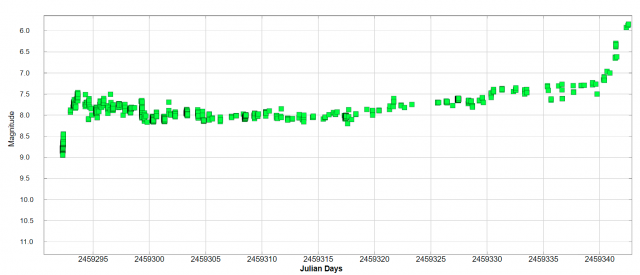 8 May 2021 at 8:52 pm #584187
8 May 2021 at 8:52 pm #584187 Mike HarlowSpectator
Mike HarlowSpectatorLuckily I was out last night (7th) taking another spectrum of the nova but with slightly better resolution. As soon as I found the field in the finderscope it was obvious the nova had brightened significantly. The spectrum now shows very well defined P-Cygni features on most of the emission lines.
Astronomer’s telegram ATel14614 gives a nice update on the nova’s evolution.
9 May 2021 at 11:57 pm #584189 Hugh AllenParticipant
Hugh AllenParticipantHi Mike,
i hope you don’t mind. I had a go at processing your spectrum image in BASS:
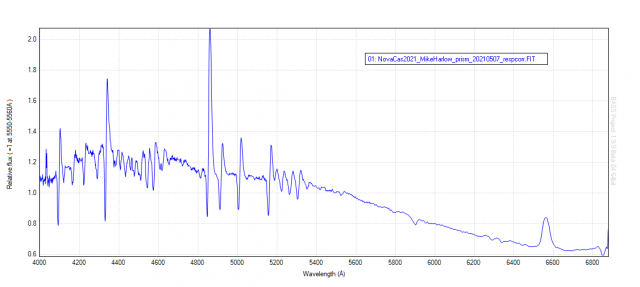
I calibrated it using the emission line wavelengths from one of my own Alpy spectra. And I made a response correction using the reference star BD +60 2540 that you highlighted in your image. I used the Pickles reference for an A5III star because there is no reference for an A5II. I think the calibration and response correction came out pretty well:
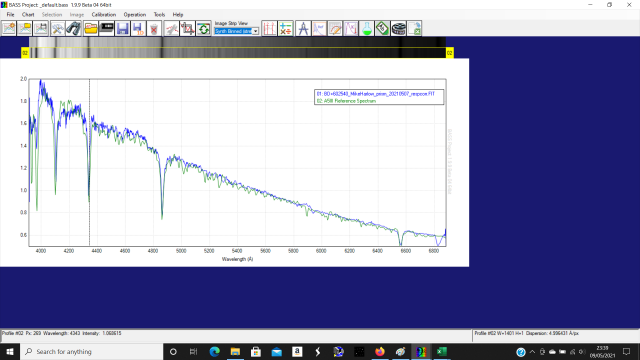
Anyway, it was a bit of fun and I think it shows the quality of your spectrum down in the green-blue end. I think the red end was maybe saturated in your image which could explain the fat, squat appearance of the Halpha emission
Cheers
Hugh
10 May 2021 at 1:59 pm #584190 Mike HarlowSpectator
Mike HarlowSpectatorHi Hugh,
Wow…that’s a really nice spectrum! I’m impressed that you got such a nice result from the .jpg without even seeing the .fts file. Anyway, it does show one thing…I need to get to grips with some spectroscopy software to produce some more useful results.
You’re right that the red end is saturated as it’s difficult to get the exposure right to show both ends correctly exposed, especially for red objects.
Some background on the prism. It was instrument no. 179 in the BAA instrument collection and I took it out on loan in 2012. Thanks to Bob Marriott for organising the loan and even delivering it in person! I purchased it from the BAA a few years back when the instrument collection was finally sold off. Apparently it has been used by some famous names in the past including Mike Hendrie and David Sinden. But most notably it was used in the 1980s and 1990s by Maurice Gavin for much of his pioneering work on spectroscopy with film and CCDs. This work was published in the BAA Journal in 1996: ‘Stellar spectroscopy with CCDs-some preliminary results’. J. Br. Astron. Assoc. 106(1) 1996, p11-15.
It may be old technology but as you’ve shown it can still produce useful spectra. And given it’s history I feel I should keep using it as long as I can.
Thanks for taking the time to analyse my spectrum…I must make more effort!
Mike.
10 May 2021 at 7:18 pm #584192 Steve BrownParticipant
Steve BrownParticipantI last viewed the nova in mid-April so I’m keen to get out to see it after the increase in brightness. Hopefully tonight will stay clear! This shot is from 12 April.
.jpg) 11 May 2021 at 8:04 am #584194
11 May 2021 at 8:04 am #584194 Andrew RobertsonParticipant
Andrew RobertsonParticipantI made a visual estimate this morning at 00:25 hrs UT using 7×50 bins and put it at mag 5.4
Andrew
11 May 2021 at 9:16 am #584195 Jeremy ShearsParticipant
Jeremy ShearsParticipantI’ve seen a naked eye observation of the nova, reported on the VSnet list. Filipp Romanov observing from Nakhodka, Russia (nr Vladivostok, 42degN) had it at 5.1 vis last night (2021 05 10.75). “It was easily seen next to the star 4 Cas against the background of the Milky Way”, Romanov notes.
This is the first NE obs report I’ve seen. It will be interesting to hear if a BAA member gets to see it with their NE, although its position is quite challenge, along with bright skies.
11 May 2021 at 11:09 am #584197 Mike HarlowSpectator
Mike HarlowSpectator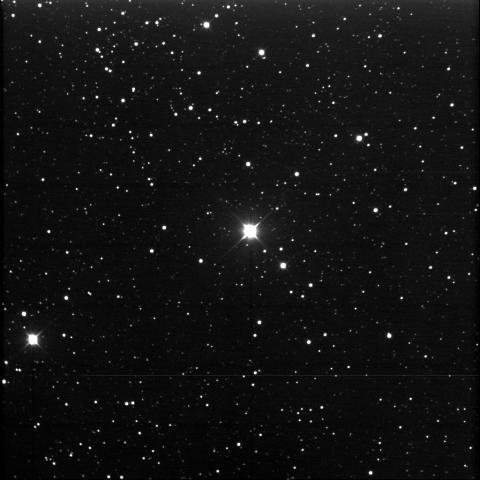
An image from 23:30UT last night (10th)…nova at centre of 25 x 25 arc minute frame, north up. It may seem like overkill to image a mag 5.3 nova with a 30cm telescope (!) but I’ll be able to follow it as it fades back to mag 18,19 or less with the same set-up. Should make a nice sequence…maybe even an animation…!?
I did look but couldn’t see it naked-eye. But it was very nice through binoculars and the 4 inch F/5 finderscope on the main telescope.
Mike.
11 May 2021 at 10:39 pm #584199 Hugh AllenParticipant
Hugh AllenParticipantAmazingly there was a hole in the weather here in Somerset last night. The nova was incredibly bright! I had to drop the camera exposure from 300 to 90sec to avoid over exposing the H alpha emission. It is now putting on a complex display of emission lines with beautiful P Cygni profiles. The H Balmer series is still prominent whilst helium emission lines have now disappeared to be replaced by a forest of singly ionised iron emission lines some of which I’ve marked. Also very striking is the pair of singly ionised calcium emission lines down in the violet, their associated blue-shifted absorption reminiscent of the solar spectrum. A wonderful spectrum!
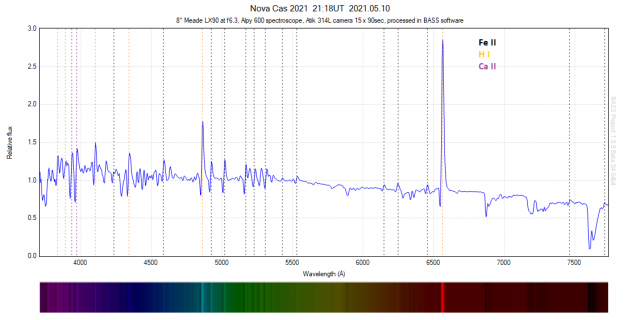 12 May 2021 at 9:42 pm #584201
12 May 2021 at 9:42 pm #584201 Mike HarlowSpectator
Mike HarlowSpectatorIdeal conditions last night to try for a higher res. spectrum; no wind and low humidity. The result is on my members page and shows some nice detail at the blue end of the spectrum.
Mike.
14 May 2021 at 2:57 pm #584203 Jeremy ShearsParticipant
Jeremy ShearsParticipantHere’s a plot from the BAA Variable Star Section database. Looks like it is past the peak, BUT this type of nova might have a second (or third) peak. Keep watching!
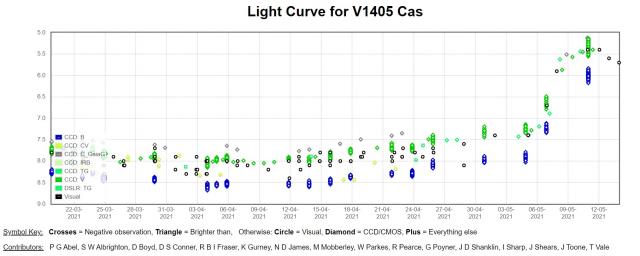 14 May 2021 at 11:27 pm #584204
14 May 2021 at 11:27 pm #584204 Steve BrownParticipant
Steve BrownParticipantI managed to get to the same site on the moors and get a shot of the brighter nova. Unfortunately, it was very windy so my capture was not as good as the previous one. You can see how much brighter it is though!
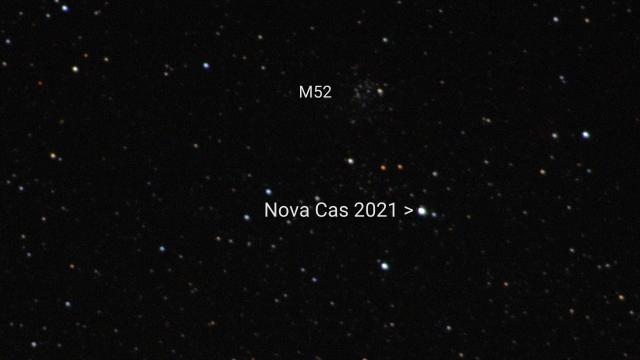 16 May 2021 at 9:24 am #584212
16 May 2021 at 9:24 am #584212 Jeremy ShearsParticipant
Jeremy ShearsParticipantKato-san posted the following on VSnet overnight:
“V1405 Cas rapid fading
Several observers have noted rapid fading.
Itoh-san’s data:
May 14 V=6.11, B-V=+0.57
May 15 V=6.95, B=V=+0.27This fading is apparently not caused by dust formation.”
16 May 2021 at 11:41 am #584216 Jeremy ShearsParticipant
Jeremy ShearsParticipantLatest plot from VSS database
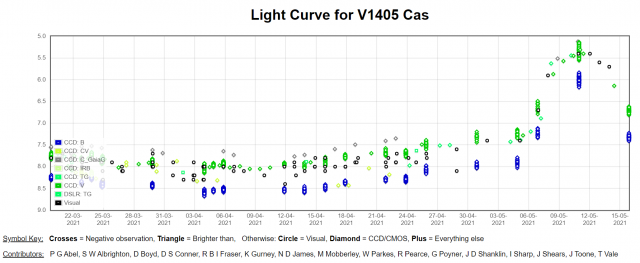 31 May 2021 at 9:12 am #584279
31 May 2021 at 9:12 am #584279 Mike HarlowSpectator
Mike HarlowSpectatorI’m still taking spectra of the nova whenever possible and the latest one from last night seems to suggest that the helium lines are coming back. Can anyone confirm this? I’m no expert on novae but I can’t remember seeing one like this before. Can anyone explain what it’s doing and has this sort of behaviour been seen before? And it appears to be creeping up in magnitude again!
Thanks,
Mike.
31 May 2021 at 12:21 pm #584281 Hugh AllenParticipant
Hugh AllenParticipantYes Mike, the HeI emission has returned amongst a few other significant changes in this wonderful nova. I’ve captured a dozen spectra since Mar 22, here’s an offset relative flux plot of a few of them showing the disappearnce and then return of the HeI emission:
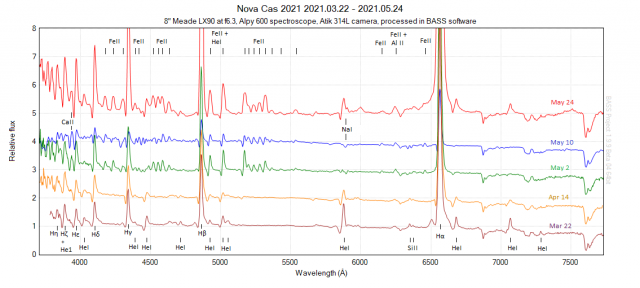
I’ve also been monitoring the expansion velocity. Until May 24 it was showing a perhaps expected gradual decline, but then briefly increased in my spectrum of May 24 around the time the nova began to brighten again. My latest spectrum from last night May 30 suggests the decline in expansion velocity has resumed accompanied by a strengthening again of the P Cygni profiles:
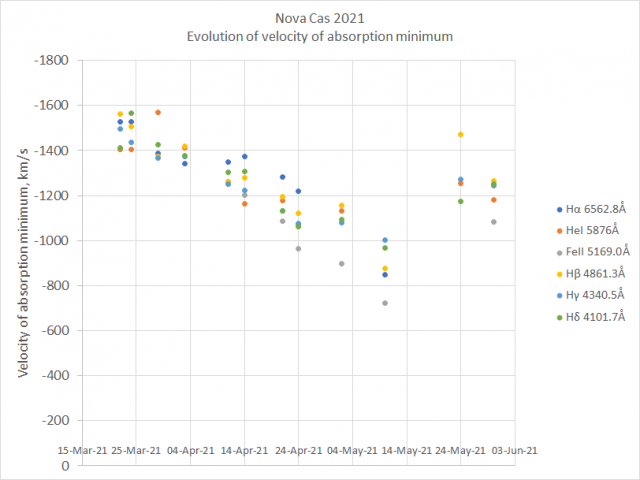
The spectrum is dominated by the overwhelming relative brightness of the H alpha emission line. Here is the spectrum from May 24:
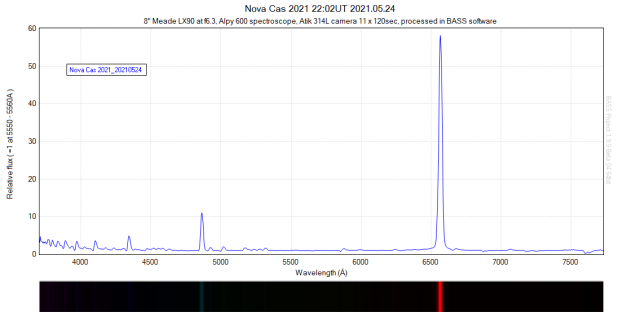
A truly remarkable object and great fun to follow in a spectroscope!
Cheers
Hugh
31 May 2021 at 4:29 pm #584282 Mike HarlowSpectator
Mike HarlowSpectatorThanks Hugh, that’s a really interesting summary of recent changes…I’m glad I was seeing something real! It will be fascinating to see what it does next…
Mike.
1 June 2021 at 1:28 pm #584284 Jeremy ShearsParticipant
Jeremy ShearsParticipantThe BAA VSS light curve indicates the nova has been gradually brightening again over the last few days.
May 31.208 7.24 TG (Gary Poyner)
May 31.995 7.1 vis (Paul Abel)
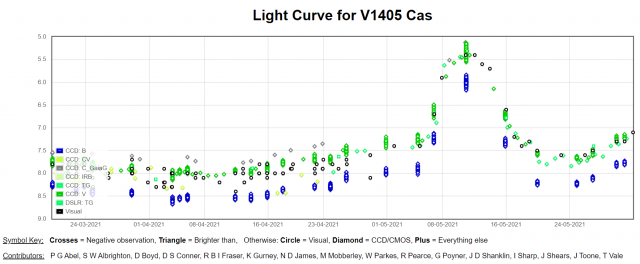
-
AuthorPosts
- You must be logged in to reply to this topic.
